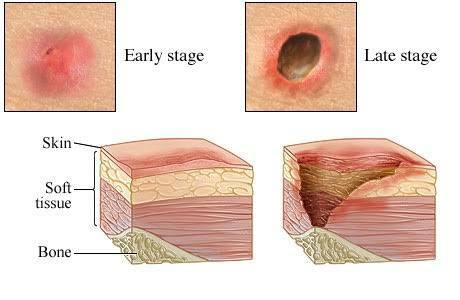sores or decubitus ulcers, result from prolonged pressure that cuts off the blood supply to the skin, causing the skin and other tissue to die. The damage may occur in as little time as 12 hours of pressure, but it might not be noticed until days later when the skin begins to break down. The skin is especially likely to develop pressure sores if it is exposed to rubbing (friction) and moving the skin in one direction and the body in another (shear), as in sliding down when the bed head is raised. Dampness (such as from perspiration or incontinence) makes the skin even more liable to develop pressure sores.
Who’s At Risk
People who cannot move themselves are at the greatest risk of getting bedsores, including people with:
Spinal cord injuryParalysisStrokesNerve (neurologic) diseaseDecreased mental awarenessMost bedsores occur in older people (over the age of 70), as the skin of older people may be thinner and may heal more slowly.
People in nursing homes and hospitalized people (particularly for hip fracture or intensive care) develop bedsores more commonly.
Signs and Symptoms
A bedsore appears first as a reddened area of skin, which then starts to break down to form an open, raw, oozing wound.
Bedsores occur at areas of abnormal pressure on the body:
In a wheelchair, this is usually the tailbone (coccyx) or buttocks area, shoulder blades, spine, or backs of the arms or legs.In a bed, they may occur on the back of the head, ears, shoulder blades, hips, lower back, tailbone, or the backs or sides of the knees, elbows, ankles, or toes.The pain level associated with bedsores depends on whether or not there is feeling in the area.
Self-Care Guidelines
Do not attempt self-care for any ulcer beyond stage 2 in appearance.
In the early stages (1 and 2) of bedsores, the area may heal with relief of pressure and by applying care to the affected skin.
A good diet will aid skin healing, especially by taking in enough vitamin C and zinc, which are available as supplements.
For effective skin care:
If the skin is not broken, gently wash the area with a mild soap and water.Clean open sores on the skin with salt water (saline, which can be made by boiling 1 quart of water with 1 teaspoon of salt for 5 minutes and kept cooled in a sterile container).Apply a thin layer of petroleum jelly (Vaseline®) and then cover with a soft gauze dressing.Be sure to keep urine and stool away from affected areas.
When to Seek Medical Care
If a stage 2 bedsore does not begin to heal in a few days, or if the sore is at stage 3 or above, seek medical advice.
Get immediate care if you notice signs of infection (fever, spreading redness, swelling, or pus).
